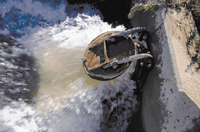Wastewater chlorination began in 1910 in Philadelphia, PA and was soon implemented in many other cities in the U.S. based on this early success.
 Disinfection of municipal wastewater is necessary to ensure healthy rivers and streams and to reduce bacteria and virus levels in downstream drinking water supplies. Microorganisms are present in large numbers in untreated sewage plant effluents, and waterborne disease outbreaks have been associated with sewage-contaminated water supplies and recreational waters.i
Disinfection of municipal wastewater is necessary to ensure healthy rivers and streams and to reduce bacteria and virus levels in downstream drinking water supplies. Microorganisms are present in large numbers in untreated sewage plant effluents, and waterborne disease outbreaks have been associated with sewage-contaminated water supplies and recreational waters.i
Chlorination is by far the most common method of wastewater disinfection and is used worldwide to kill pathogens before wastewater is discharged into streams, rivers or oceans.ii Wastewater disinfection also prevents the accumulation of toxic microorganisms in fish, shellfish and other aquatic organisms. And where sources of drinking water supplies may be contaminated by wastewater effluent, the importance of applying disinfection at both the wastewater plant and drinking water plant cannot be overstated.
Preventing Infectious Diseases
Disinfection is the most important step in wastewater treatment. Chlorine effectively destroys a variety of bacteria, viruses and protozoa, including Salmonella, Shigella and Vibrio cholera. By killing these microorganisms, chlorination helps reduce the risk of disease.
Important Benefits of Chlorine Treatment
Chlorination plays a key role in the wastewater treatment process by killing or inactivating pathogens and removing or destroying other physical and chemical impurities. Chlorine's important benefits to wastewater treatment include:iii
- Disinfection
- Controlling odor and preventing septicity
- Aiding scum and grease removal
- Controlling activated sludge bulking
- Controlling foaming and filter flies
- Stabilizing waste-activated sludge prior to disposal
- "Scrubbing" foul air
- Destroying cyanides and phenols
- Removing ammonia
- Reclamation and Reuse
Wastewater can be reclaimed and reused through treatment programs that reduce environmental degradation caused by sewage effluent disposal and provide an alternative water supply to help overcome shortages in potable water. Reclaimed water is used for agriculture, industry, drinking water and groundwater recharge.
Reuse efforts can significantly reduce wastewater discharges. Such efforts are being implemented in numerous communities around the world. Chlorination is an important component in this strategy. The state of California requires reclaimed water to be disinfected. In England, innovative techniques make it possible to disinfect and feed reused water back into taps an average of seven times before the water finally reaches the sea.
i WPCF Task Force on Wastewater Disinfection. Wastewater Disinfection Manual of Practice No. FD -10. Water Pollution Control Federation. 1986.
ii Stover, E.L., Haas, C.N., Rakness, K.L. and Scheible, O.K. Design Manual: Municipal Wastewater Disinfection. U.S.Environmental Protection Agency. 1986.
iii White, G.C. Handbook of Chlorination, 2nd ed. Van Ostrand Reinhold Company. 1986.